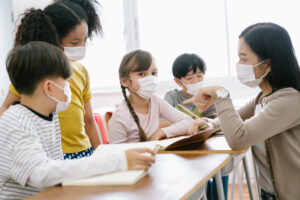 We now know that childhood trauma, including ongoing toxic stress, has a profound impact on brain development and behavior. In fact, behaviors teachers see in the classroom that seem to make no sense may actually be a student’s adaptive responses that show a brain’s capacity for prioritizing survival.
We now know that childhood trauma, including ongoing toxic stress, has a profound impact on brain development and behavior. In fact, behaviors teachers see in the classroom that seem to make no sense may actually be a student’s adaptive responses that show a brain’s capacity for prioritizing survival.
When we blame the student or take behavior personally, our responses may be hurtful rather than helpful. Over the past 18 months, as the effects of the pandemic have further increased stress and struggle for all families, especially those from marginalized and Brown and Black populations, teachers may see a good deal more dysregulation from their students.
What can we, as educators, do?
Connect in mini moments: Doctor Bruce Perry, renowned trauma expert and co-author of What Happened to You? explains that it is who you are in the moment that matters. His short video describes how tiny moments of connection help regulate a student and make them feel safe, making their brains more open to learning. Using a student’s name, making quick, kind eye contact, telling a joke, or giving a smile represent tiny moments that help regulate a student during their day.
Be sure that you yourself are regulated: Being relationally present and respectful requires that you are regulated. Awareness of the effects of vicarious or secondary trauma and burnout is important. Children are watching how you treat others. If you treat a struggling student with dignity and respect, they will feel safe and believe that they are equally valued. How do you take care of yourself? Practicing this is crucial work.
Become Curious: When we are having difficulties with a student, it is a sign that the student is struggling. Notice when those feelings come up. Ask questions rather than ascribe blame. Connect and get to know the student more deeply. When we learn about our student’s lives, we are better able to be compassionate and make connections. One teacher shared how that information made all the difference.
There are many ways to make a difference: We know that our school systems can have a powerful role in healing when they are trauma informed and prioritize trauma-informed practices. Kaiser Permanente reports that “to be trauma-informed, it’s also important that schools teach social-emotional skills, embed participatory decision-making by students in school policies, and explicitly work to involve families and communities.” Regular classroom meetings offer an effective way for students to practice and develop these skills.
Ask, “What does this student need to reach their potential” The shift in perspective from, “What is wrong with you?” to “What happened to you?” and on to “What does this student need?” allows teachers to shift focus from what is wrong to what is possible. In the article Five Ways to Support Students Affected by Trauma, focusing on a student’s strengths is one primary way to empower students exposed to trauma.
Join us for a conversation about the new book What Happened to You? by Dr. Perry and Oprah Winfrey on Wednesday, November 3, 6 – 7:30pm. Reserve your spot ASAP!
